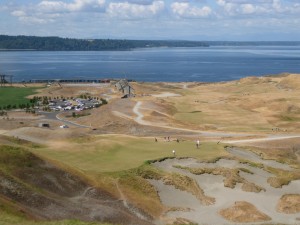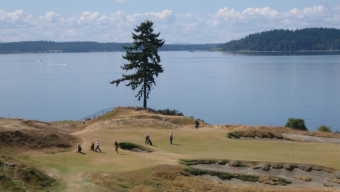(Editor’s Note: With the U.S. Open starting June 18, Golferswest.com will re-publish many of the stories our writers have written of the course over the past months and years. This one deals with the various and challenging par-3s at Chambers Bay)
UNIVERSITY PLACE, Wa. — There’s not a par-3 hole at Chambers Bay that isn’t undergoing some sort of change for the 2015 U.S. Open.
Much of the work stretches holes that already are a challenge into lengths that could be terrifying to anyone but a savvy Tour pro – and some of them might get a little weak in the knees.
New tee boxes will give the USGA an option to play a hole such as No. 15 – the one toward the water with the lone tree in the background – from as close as 140 yards or as far away as 240. No. 3, playing 165 yards from the back tee today, will stretch to as much as 200 yards for the Open. The 17th could play from 150 yards or 220, depending on where the pin is placed on a green with more lumps than a boxer’s face.
That’s just the routine stuff.
You want drastic? Then take a look at what those devilish USGA folks have in mind for No. 9, the one on the ridge overlooking the entire property.
The ninth is a favorite of those who have played the course since it opened, partly because the tee box is the highest point on the course – some 100 feet above the green below. It’s where you drag the camera out of the bag and take a photo of the foursome, with Puget Sound and the islands off in the picturesque distance.
The back tee plays 227 yards, but the elevation change makes it as much as a two-club difference. Put it this way, last time I played the course I hit 6-iron from 202 yards and got lucky enough to bounce one just past the pin. The only other time I hit 6-iron from that distance is in my dreams, when I think I’m Bubba Watson needing to hit a high cut.

Chambers No. 9, with the tee sitting high on the ridge, might be the most compelling hole during the 2015 Open.
No. 9 will be a marquee hole in the Open because of the elevated tee, the Chamber of Commerce view and a left-to-right sloping green that will reward golfers who bounce a shot onto the putting surface from the left. A ball could have five seconds of hang time in the air, then another five seconds of roll.
But there’s more. A whole lot more.
As soon as the Tour pros figure out the elevation/club selection/green contour from up top on No. 9, it appears the USGA will throw them a huge changeup for at least one round of the Open. Another tee location will be built down below– at roughly the same level as the green – for what will be a shot of about 200 yards from a completely different angle.
Call it 9B, and we’ll let the Tour pros decide what the B stands for.
“It’s a totally different look, different direction and different wind,” said Matt Allen, general manager at Chambers Bay. “The new tee on No. 15 will give them the option of playing it from 140 to 240 yards, but I think this is more dramatic.”
The obvious question is why change something that’s already so good?
USGA Executive Director Mike Davis wants at least one level par-3 from tee to green, and every other par-3 on the course is likely to play from elevated tees.
“All we are doing there is adding a little flexibility,” Davis said. “We are going to put a tee down. As the hole plays, it will be down the hill. We worked with the architects on this. What we want is a hole that will play level and maybe a little bit uphill on a day or two. The idea there is we will use the same tees we used for the amateurs up top, but we just found that with certain hole locations when it gets firm, some of the hole locations didn’t work as well as we thought they should have.
“We haven’t even built the new tee on No. 9, but it probably will be in the 175- to 200-yard range from the tee at same height as the green. We want it to be anywhere from a 5-iron to a 7-iron shot for the guys.”
Also, if you think about the par-3s at Chambers Bay, just about everyone plays downhill and that is the reason we are playing No. 17 from the lower tee every day. We don’t think every par-3 should be a downhill shot.”
Allen added, “Mike is really wanting a more level par-3. The new tees on No. 3 are elevated, No. 9 is elevated and one tee option on No. 17 is elevated.”
That should be intriguing, as are the other par-3s at the Open. Here’s a look at the others:
No. 3 – 200 yards
The third hole currently plays 165 yards from the back tee, but a new tee box will stretch that by another 35 yards and put a longer club in the pros’ hands.
The green slopes from right to left and front to back, with deep sand guarding front left. There’s a convenient a landing spot short right that will kick the ball toward the left, perfect when there’s a back left hole location.
You can’t play that shot to a front-right location, however. That will require an extremely precise shot off the tee – and maybe a little prayer because of all that sand in front of the green.
“With that front right location, the key is a nice high cut about three feet right of the hole,” Allen said.
No. 15 – 140-240 yards
If the changes to the No. 9 hole (pictured at top) weren’t so drastic, this would be the most dramatically different par-3 on the course from round-to-round. It could play from 140 yards one day, then 240 the next.
There’s a nice bank left of the green that will funnel shots toward the putting surface, and it’s bound to be a popular landing spot as golfers avoid the vast amount of sand front and right of the green. Beware, though, a deep bunker behind the green can swallow a tee shot that’s too deep. From 240 yards, it’ll be a challenge.
“It’s all about hole location,” Allen said. “From 240 yards, back left is where they can use the backstop. But if they go for the backstop, the back pot bunker comes into play.”
No. 17 – 150-220 yards
This is another made-for-TV hole, with Puget Sound glistening to the right and a roly-poly green offering all kinds of pin-location options. There are options with the tees as well, with distances ranging from 150-220 yards and the possibility of playing from tees that are elevated or one that’s level with the green. Davis says No. 17 will play from the lower, longer tee throughout the Open.
“If you think about the par-3s at Chambers Bay, just about every one plays downhill and that is the reason we are playing No. 17 from the lower tee every day,’ Davis said. “We don’t think every par-3 should be a downhill shot.”
The lower tee is from the longer distance, and golfers can see only a portion of the green from there.
A back-left hole on this green appears, from the tee, to be a dastardly location. Leave the shot short and golfers have an over-the-hump putt that could be difficult to stop near the hole. When we played that hole with Allen, he hit his tee shot beyond the green and putted back up the hill. Look for that play a lot when there’s a back hole in the Open.





















